Do you have a question about the Boss Super Octave OC-3 and is the answer not in the manual?
World's first octave pedal with polyphonic input, freeing guitarists from monophonic limitations.
Features OC-2 mode for compatibility with the popular OC-2 pedal, allowing blend of two octaves.
Includes a "Drive mode" for wild octave effects and added distortion to sounds.
Equipped with a BASS IN jack for octave effects suited for basses, switching internal processing.
Enables separate output of the direct and octave sounds.
OC-3 is monophonic except in POLY mode; avoid chords and ensure clear note separation.
Connect directly to guitar/bass output; using a compressor/limiter provides stable performance.
Turn down guitar/bass tone when playing in lower registers or if OC-3 outputs sounds incorrectly.
Recommend front pickup for performance; humbucking pickups offer more stable operation.
In POLY mode, octave sound volume drops above 5th fret (guitar) or 14th fret (bass). Use OCT2 mode for high registers.
Using the OC-3 in POLY mode provides a more stable octave sound compared to other modes.
Accepts connection of an AC Adaptor (optional BOSS PSA-Series) for continuous power.
Shows if an effect is ON/OFF; doubles as Battery Check indicator, lighting when effect is ON.
DIRECT OUT and OUTPUT (MONO) jacks connect unit to amplifier or other effects units.
GUITAR IN and BASS IN jacks accept input signals from guitars, basses, or other instruments.
Used for switching effects on/off.
Loosening this screw opens the pedal, allowing battery changes.
Adjusts the volume of the direct sound; also adjusts total volume when MODE is set to DRIVE.
Adjusts the level of the sound one octave below the original.
Function changes by MODE knob setting (RANGE, OCT2 Level, or DRIVE).
Switches the octave effect; changes function of the CONTROL knob.
Depress the pedal switch to turn the effect on; CHECK indicator turns red.
Select the desired mode using the MODE knob.
Use the CONTROL knob to adjust range, -2 octave level, or drive effect based on mode.
Use the OCT1 LEVEL knob to adjust the volume of the sound one octave down.
Use the DIRECT LEVEL knob to adjust the direct sound volume level.
Loosen the thumbscrew at the pedal's front and lift the pedal upwards to open.
Remove the old battery from housing and disconnect the snap cord.
Connect the snap cord to the new battery and place it inside the battery housing, observing polarity.
Slip the coil spring onto the spring base on the back of the pedal and close the pedal.
Insert the thumbscrew into the guide bush hole and fasten it securely.
Checks for proper adaptor connection, battery status, and guitar/bass connection.
Replace the battery if it is low or dead, as indicated by a dim or unlit CHECK indicator.
Ensure the guitar or bass is properly connected to the GUITAR IN or BASS IN jack.
Checks for proper OC-3 connection, amp volume settings, and DIRECT OUT connection.
Addresses potential causes like low battery or excessive input sound level.
World's first octave pedal with polyphonic input, freeing guitarists from monophonic limitations.
Features OC-2 mode for compatibility with the popular OC-2 pedal, allowing blend of two octaves.
Includes a "Drive mode" for wild octave effects and added distortion to sounds.
Equipped with a BASS IN jack for octave effects suited for basses, switching internal processing.
Enables separate output of the direct and octave sounds.
OC-3 is monophonic except in POLY mode; avoid chords and ensure clear note separation.
Connect directly to guitar/bass output; using a compressor/limiter provides stable performance.
Turn down guitar/bass tone when playing in lower registers or if OC-3 outputs sounds incorrectly.
Recommend front pickup for performance; humbucking pickups offer more stable operation.
In POLY mode, octave sound volume drops above 5th fret (guitar) or 14th fret (bass). Use OCT2 mode for high registers.
Using the OC-3 in POLY mode provides a more stable octave sound compared to other modes.
Accepts connection of an AC Adaptor (optional BOSS PSA-Series) for continuous power.
Shows if an effect is ON/OFF; doubles as Battery Check indicator, lighting when effect is ON.
DIRECT OUT and OUTPUT (MONO) jacks connect unit to amplifier or other effects units.
GUITAR IN and BASS IN jacks accept input signals from guitars, basses, or other instruments.
Used for switching effects on/off.
Loosening this screw opens the pedal, allowing battery changes.
Adjusts the volume of the direct sound; also adjusts total volume when MODE is set to DRIVE.
Adjusts the level of the sound one octave below the original.
Function changes by MODE knob setting (RANGE, OCT2 Level, or DRIVE).
Switches the octave effect; changes function of the CONTROL knob.
Depress the pedal switch to turn the effect on; CHECK indicator turns red.
Select the desired mode using the MODE knob.
Use the CONTROL knob to adjust range, -2 octave level, or drive effect based on mode.
Use the OCT1 LEVEL knob to adjust the volume of the sound one octave down.
Use the DIRECT LEVEL knob to adjust the direct sound volume level.
Loosen the thumbscrew at the pedal's front and lift the pedal upwards to open.
Remove the old battery from housing and disconnect the snap cord.
Connect the snap cord to the new battery and place it inside the battery housing, observing polarity.
Slip the coil spring onto the spring base on the back of the pedal and close the pedal.
Insert the thumbscrew into the guide bush hole and fasten it securely.
Checks for proper adaptor connection, battery status, and guitar/bass connection.
Replace the battery if it is low or dead, as indicated by a dim or unlit CHECK indicator.
Ensure the guitar or bass is properly connected to the GUITAR IN or BASS IN jack.
Checks for proper OC-3 connection, amp volume settings, and DIRECT OUT connection.
Addresses potential causes like low battery or excessive input sound level.
| Brand | Boss |
|---|---|
| Model | Super Octave OC-3 |
| Category | Music Pedal |
| Language | English |
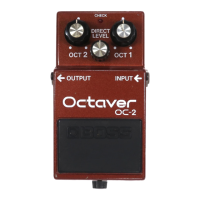
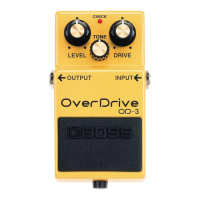
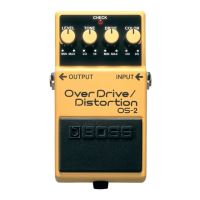
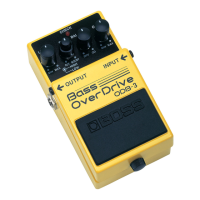
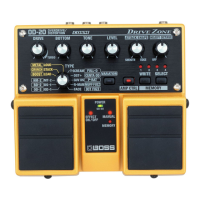
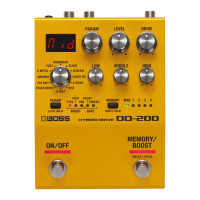
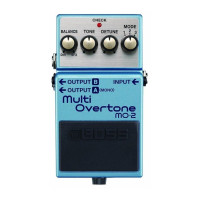
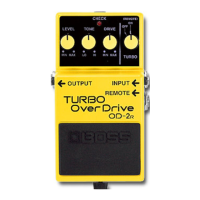
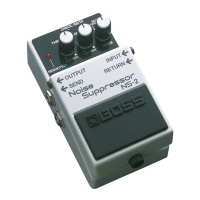
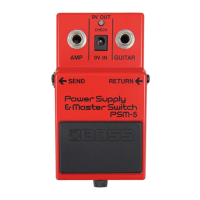
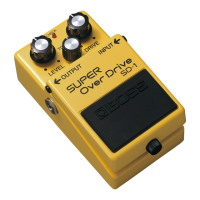
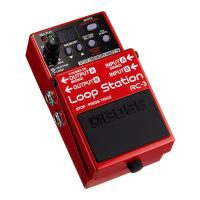
